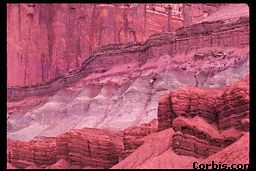 |
| ROCKS |
| Look anywhere around you the next time you are walking outside and chances are you will see several different types of rock. From the soil in which we plant our crops to the world's tallest mountains, rocks exist around us everywhere. And yet with such a proliferation of rock(the entire earth, essentially), there are only three basic rock types; sedimentary, metamorphic and igneous. This page will deal with those rock types and the forces that create them; the Rock Cycle. |
| SEDIMENTARY ROCKS |
| Sedimentary rocks are the most common type of rock on the earth, covering about 75% of the earth's surface and the one you are most likely to spot if you are out looking or collecting rocks. Sedimentary rocks are formed by the compaction and cementation of smaller sediments to form a larger rock. Sedimentary rocks are broken down further into three main groups based upon their composition. These groups are clastic, chemical and organic sedimentary rocks. |
| Clastic sedimentary rocks are formed from solid particles that were eroded from other preexisting rocks. Some examples would be sandstone, shale and conglomerate. |
| Chemical sedimentary rocks are formed by the precipitation of minerals dissolved in water. Simply stated they are made when water with minerals in it evaporates and leaves behind a residue of chemical sediments. Examples include limestone and halite(table salt). Another direct formation are the icicle-shaped stalactites and stalagmites that are found in caves. As water seeps through the roof it leaves behind the deposits that build these formations. |
| Finally, there are organic sedimentary rocks which basically are another form of chemical rock or biochemical in this case as the particles that form these sedimentary rocks come from once living organisms like fossil remains, shell fragments and even plants. Some examples include chalk, coal and organic limestone. |
| METAMORPHIC ROCKS |
| Metamorphic rocks, as the name implies are formed when preexisting rocks are metamorphosed or changed into another type of rock. This change is brought about by heat, pressure and moisture. There are two types of meta- morphism; contact and regional. Contact metamorphism occurs when hot igneous rock intrudes into some pre-existing rock. The rock is changed into another type when the mineral structure is changed by the heat, forming a new rock. Regional metamorphism occurs over a large area. There are two basic types of metamorphic rock; foliated and unfoliated. Some examples are slate, gneiss and marble. |
| Foliation in metamorphic rocks occurs when the flat minerals within the rock are squeezed by pressure so that they become aligned producing a sheetlike structure that shows the direction from which the pressure was applied. |
| Metamorphic rocks with no foliation do not have a sheetlike structure. No matter how much pressure is applied, the minerals just will not align. |
| IGNEOUS ROCKS |
 |
| Igneous rocks are formed when magma(hot liquid rock) from deep inside the earth hardens and cools. The rate of cooling and chemical composition determines what type of igneous rock will form. There are two types of igneous rock; intrusive and extrusive igneous rock. |
| Intrusive or plutonic igneous rocks are formed when magma cools and solidifies deep within the earth. These are characterized by large mineral grains due to the slow cooling period. Examples are granite and gabbro. |
| Extrusive or volcanic igneous rocks are formed when magma cools above or at the earth's surface. This rapid cooling produces very small mineral grains or none at all, as in the example of obsidian or volcanic glass. Other examples include pumice and scoria. |
| GRANITE |
 |
 |
 |
| GNEISS |
 |
| CONGLOMERATE |
| LIMESTONE |
| THE ROCK CYCLE |
 |
| The rock cycle starts with molten rock (magma), which cools and forms igneous rocks. These rocks get uplifted as part of mountain-building and then begin to weather and erode. The eroded material is carried away by rivers, wind, glaciers, etc. and deposited elsewhere as sediments. These sediments then are buried and formed into sedimentary rocks. Then these sedimentary rocks are buried, subjected to heat, pressure, and fluids, and become metamorphic rocks. Eventually, these metamorphic rocks may be heated to the point where they again melt into magma. However, it is possible to skip over any of these steps. |
| UNIV. OF SASKATCHEWAN |